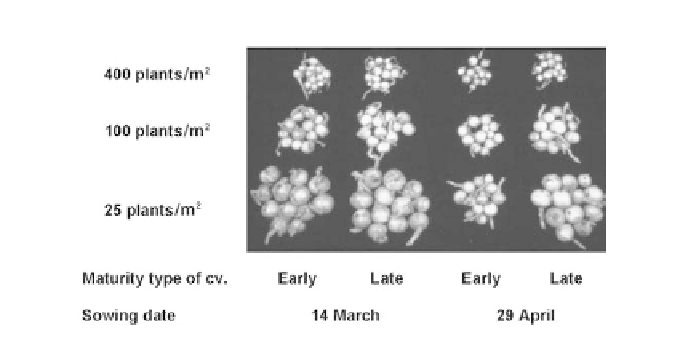Agriculture Reference
In-Depth Information
season. If this is the case, the size of bulbs can be controlled to a considerable
extent by the planting density (see Fig. 6.7). For example, the small bulbs (sets)
used for planting in the following year are grown at a density of 1000-2000
plants/m
2
, whereas 5-7 cm diameter bulbs for cooking must be grown at
50-100 plants/m
2
. To produce larger 'jumbo' bulbs, planting densities of
25-50 plants/m
2
are used. Onion bulb yields increase to an asymptote as plant
density increases, and mean bulb size correspondingly declines (see Fig. 6.8).
The maximum yield attained at high density depends on growing
conditions, particularly soil fertility and water availability. The highest yields
attained in fertilized irrigated plots or under fertigation are about 100-120
t/ha (about 10 t/ha of dry matter). Good commercial yields are about half this
amount. In drier, poorer, less fertile parts of the world yields are much lower on
average. It follows that the yield:density relationship depends on fertility and,
therefore, so does the spacing needed to produce a particular mean bulb
weight. If the crop yield can be forecast, Eqn 6.1 can be used to specify the plant
density needed to produce bulbs of the required weight:
(Bulb Weight)
-1
= A + B
(Plant Density)
(Eqn 6.1)
A and B are fitted parameters, where 1/A corresponds to the maximum
bulb size attainable at very low densities and 1/B corresponds to the maximum
or asymptotic yield attained at high densities. The value of 1/B measures the
'yield potential' of the environment. Equation 6.2 can be used to estimate
diameter from weight (Rogers, 1978):
log
10
(bulb diameter(mm)) = 1.02 + 0.364log
10
(fresh wt(g))
(Eqn 6.2)
Equation 6.2 is slightly inaccurate because the length:diameter ratio of
bulbs tends to increase as plant density increases.
Fig. 6.7.
The effects of plant density, sowing date and cultivar on the bulb size at
harvest of spring-sown onions (photograph courtesy of Warwick HRI, UK).


